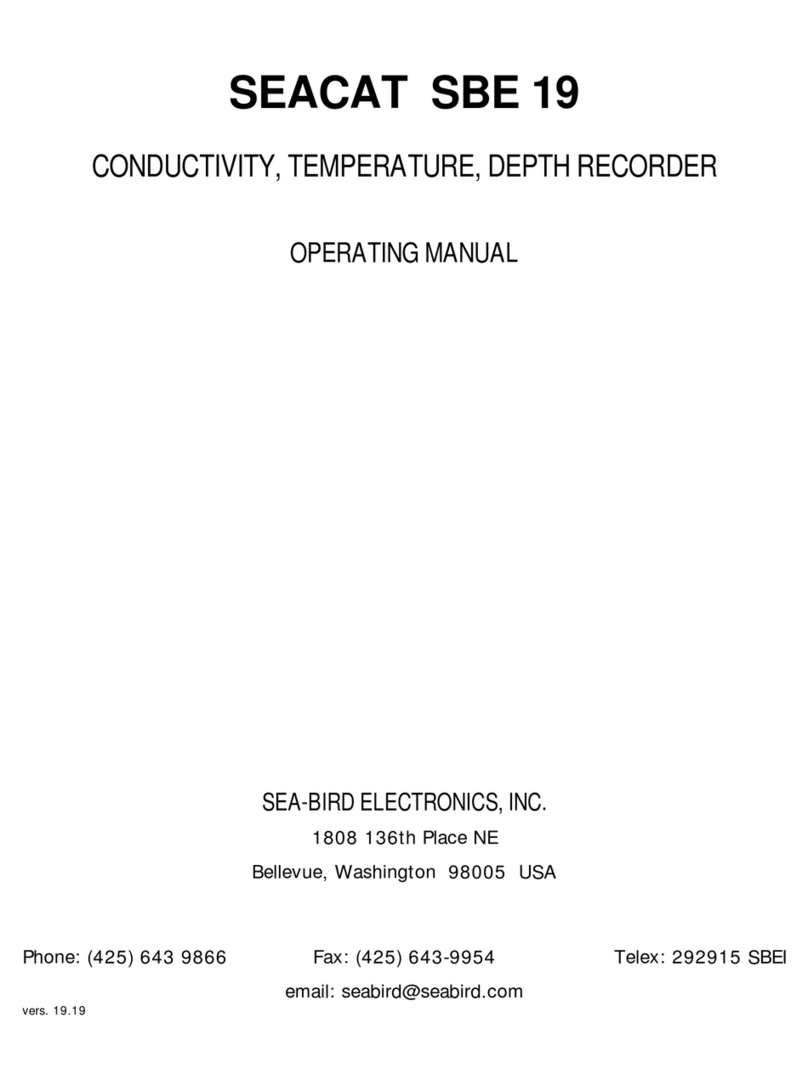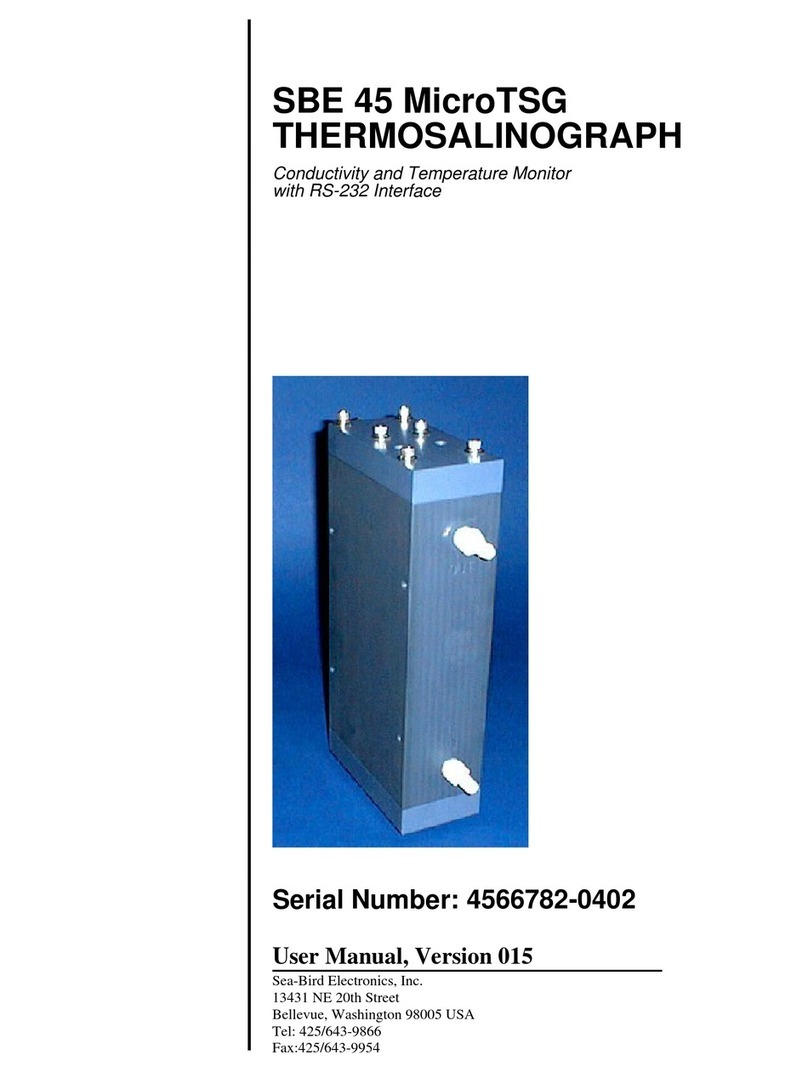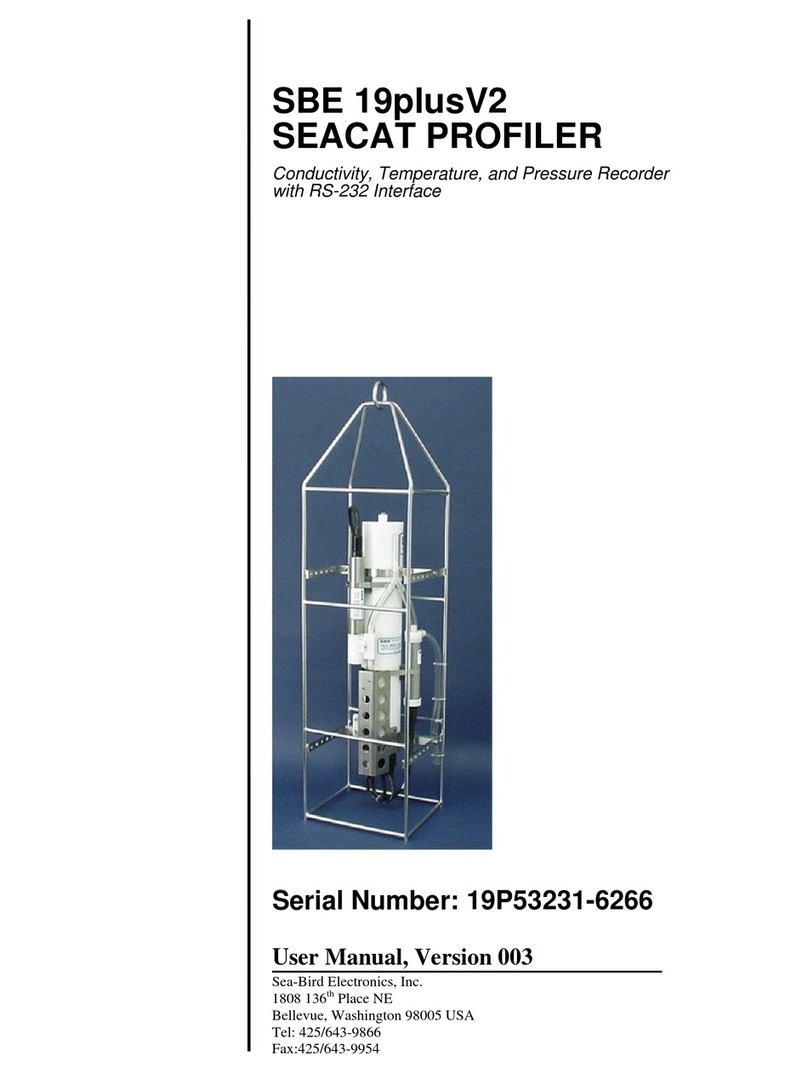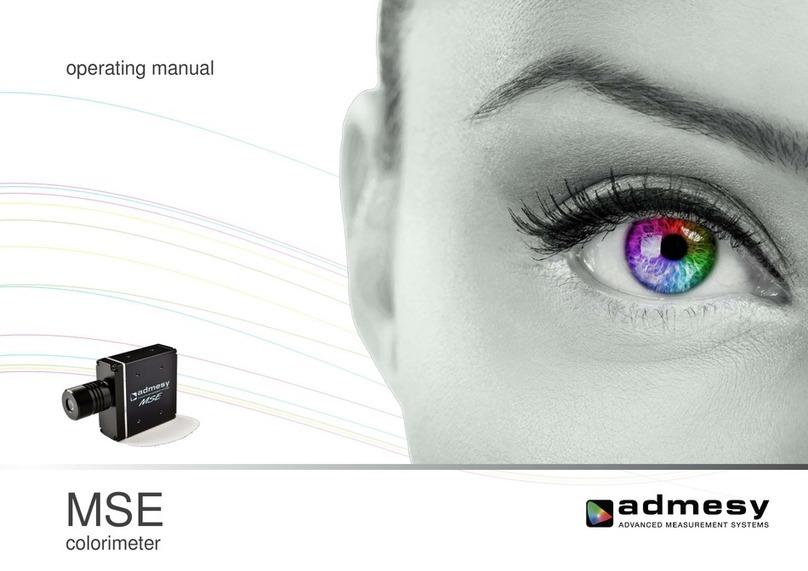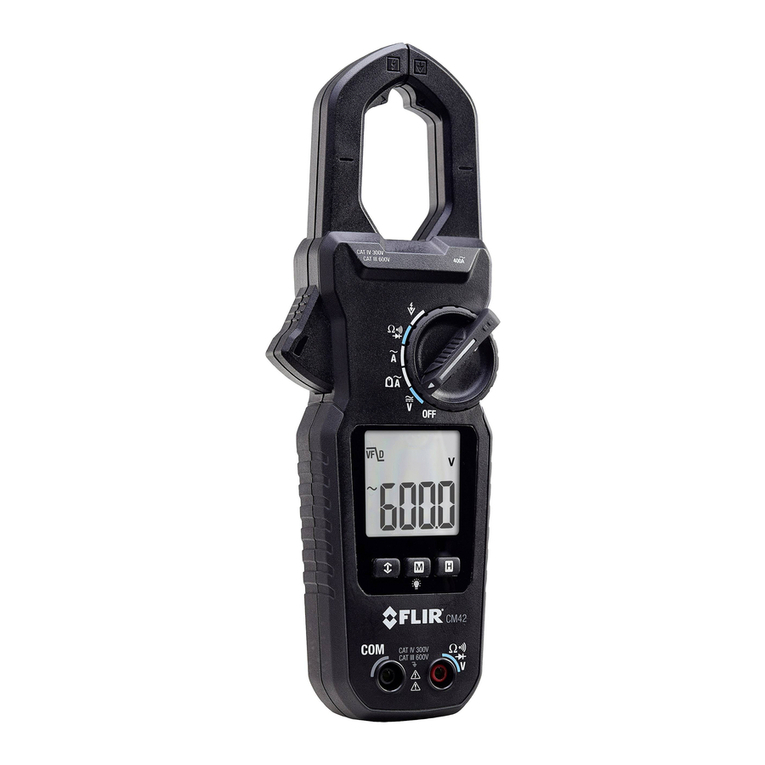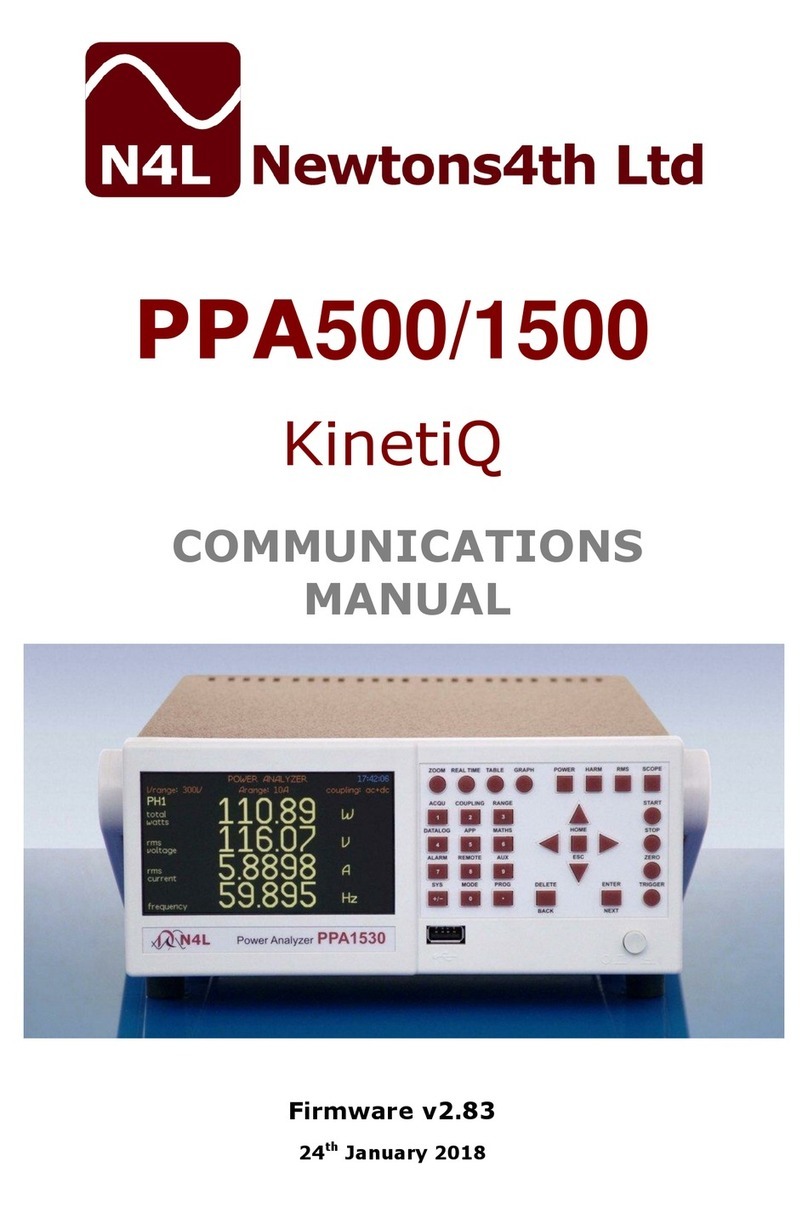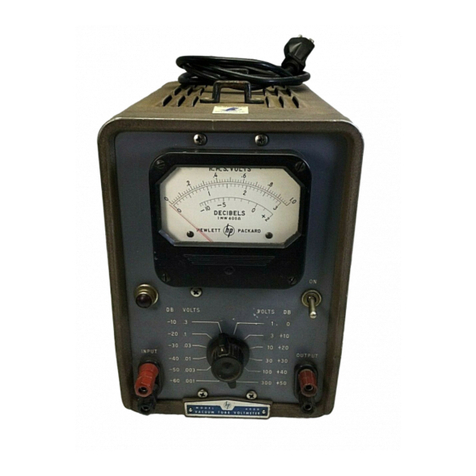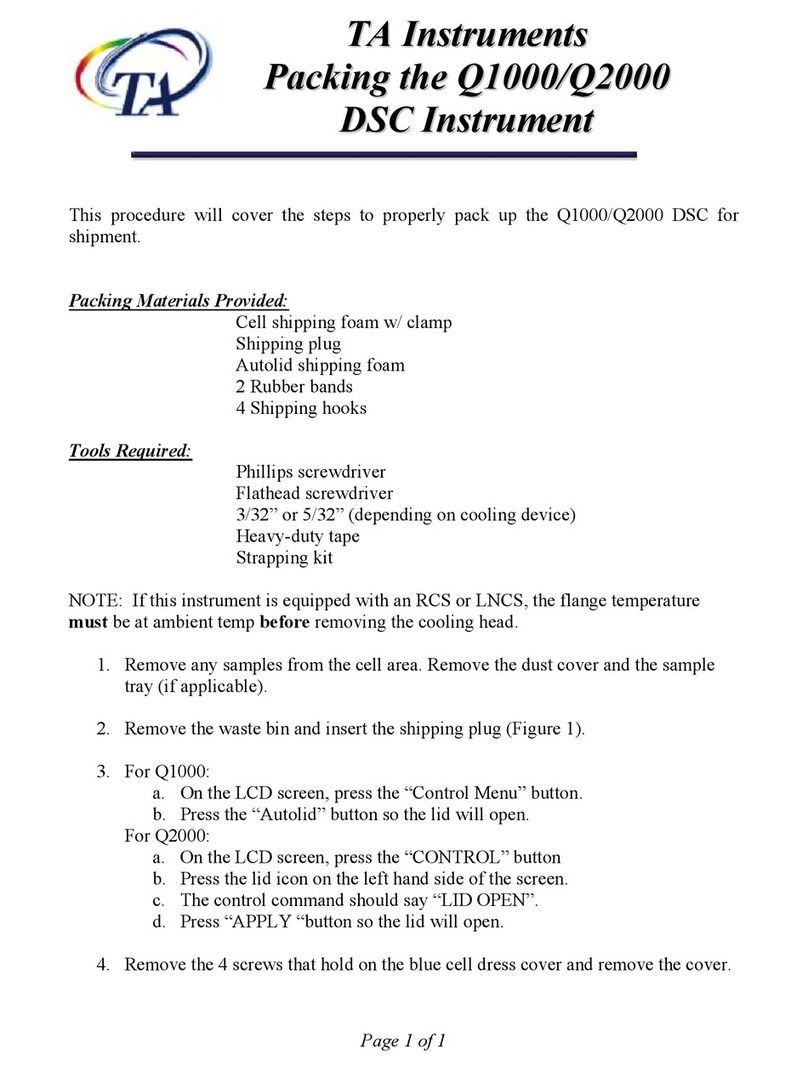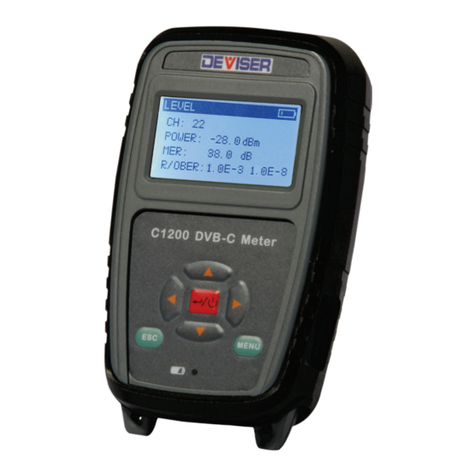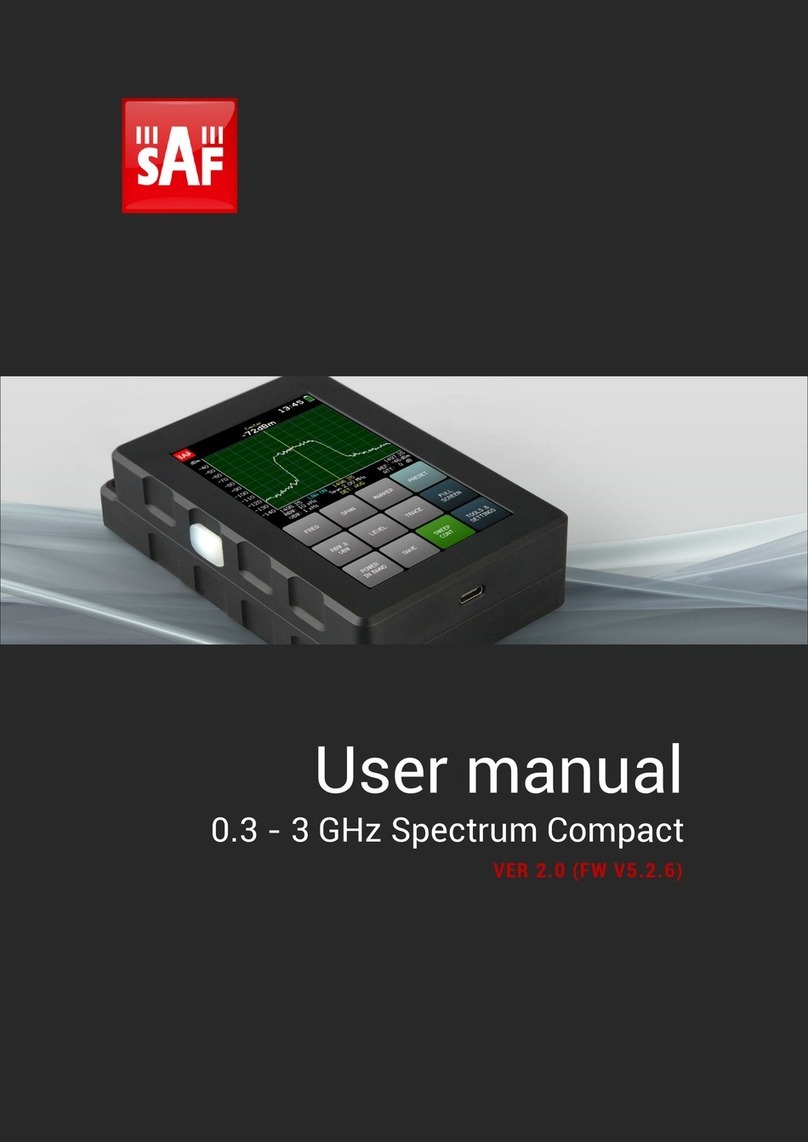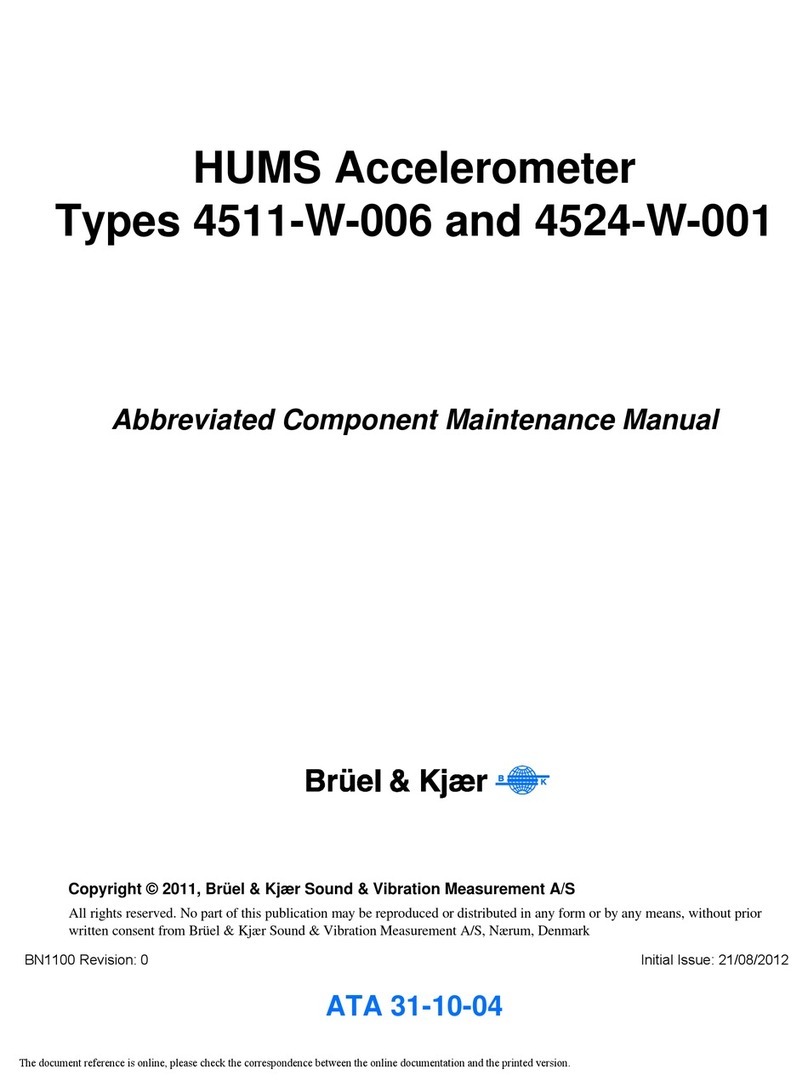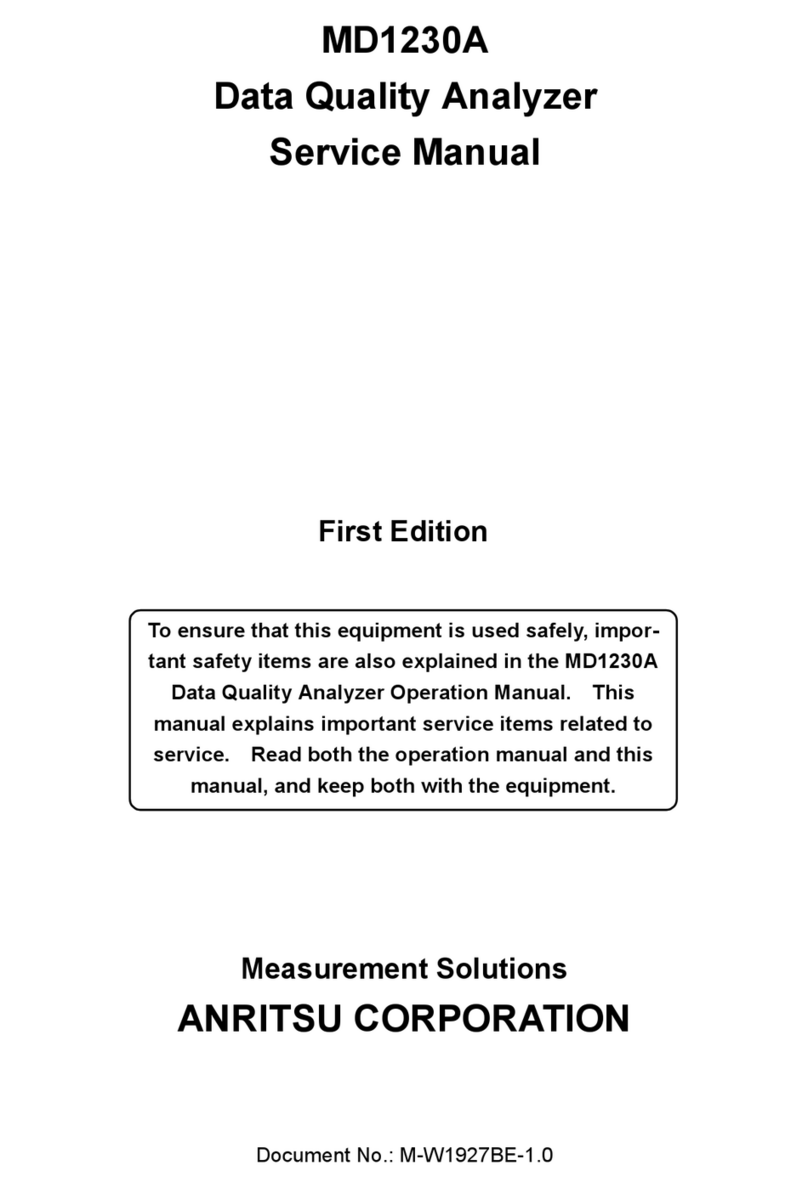Sea-Bird Electronics SBE 37-SMP MicroCAT User manual

SBE 37-SMP MicroCAT
Conductivity, Temperature, and (optional) Pressure Recorder
with RS-232 Interface and Integral Pump
Shown with optional ShallowCAT plastic housing;
standard titanium housing available
User’s Manual
Sea-Bird Electronics, Inc.
13431 NE 20th Street
Bellevue, Washington 98005 USA
Telephone: +1 425-643-9866 Manual version #019, 09/19/13
Fax: +1 425-643-9954 Firmware version 4.1 and later
E-mail: [email protected] SeatermV2 version 2.3.0 and later
Website: www.seabird.com SBE Data Processing version 7.23.1 and later
For most
applications,
deploy in
orientation
shown
(connector
end down) for
proper
operation

2
Limited Liability Statement
Extreme care should be exercised when using or servicing this equipment. It should be used or serviced
only by personnel with knowledge of and training in the use and maintenance of oceanographic
electronic equipment.
SEA-BIRD ELECTRONICS, INC. disclaims all product liability risks arising from the use or servicing
of this system. SEA-BIRD ELECTRONICS, INC. has no way of controlling the use of this equipment
or of choosing the personnel to operate it, and therefore cannot take steps to comply with laws
pertaining to product liability, including laws which impose a duty to warn the user of any dangers
involved in operating this equipment. Therefore, acceptance of this system by the customer shall be
conclusively deemed to include a covenant by the customer to defend, indemnify, and hold SEA-BIRD
ELECTRONICS, INC. harmless from all product liability claims arising from the use or servicing of
this system.

Manual revision 019 Declaration of Conformity SBE 37-SMP RS-232
3
Declaration of Conformity

Manual revision 019 Table of Contents SBE 37-SMP RS-232
4
Table of Contents
Limited Liability Statement ................................................................ 2
Declaration of Conformity .................................................................. 3
Table of Contents ................................................................................. 4
Section 1: Introduction ........................................................................ 6
About this Manual .............................................................................................6
Quick Start .........................................................................................................6
Unpacking MicroCAT .......................................................................................7
Shipping Precautions .........................................................................................8
Section 2: Description of MicroCAT.................................................. 9
System Description ............................................................................................9
Specifications...................................................................................................11
Dimensions and End Cap Connector ...............................................................12
Cables and Wiring ...........................................................................................13
Sample Timing.................................................................................................14
Battery Endurance............................................................................................14
External Power.................................................................................................15
Cable Length and External Power ............................................................15
Section 3: Preparing MicroCAT for Deployment........................... 17
Battery Installation...........................................................................................17
Software Installation ........................................................................................19
Power and Communications Test ....................................................................19
Test Setup .................................................................................................19
Test ...........................................................................................................20
Section 4: Deploying and Operating MicroCAT............................. 25
Sampling Modes ..............................................................................................25
Polled Sampling........................................................................................26
Autonomous Sampling (Logging commands) ..........................................27
Serial Line Synchronization (Serial Line Sync) .......................................28
Real-Time Data Acquisition ............................................................................29
Timeout Description ........................................................................................29
Command Descriptions....................................................................................30
Data Formats....................................................................................................45
Optimizing Data Quality / Deployment Orientation ........................................47
Setup for Deployment ......................................................................................48
Deployment......................................................................................................49
Recovery ..........................................................................................................50
Uploading and Processing Data .......................................................................51
Editing Raw Data File......................................................................................58
Section 5: Routine Maintenance and Calibration........................... 59
Corrosion Precautions......................................................................................59
Connector Mating and Maintenance ................................................................59
Conductivity Cell Maintenance .......................................................................60
Plumbing Maintenance ....................................................................................60
Handling Instructions for Plastic ShallowCAT Option ....................................61
Replacing Batteries ..........................................................................................62
Pressure Sensor (optional) Maintenance..........................................................62
Replacing Anti-Foulant Devices – Mechanical Design Change ......................63
Replacing Anti-Foulant Devices (SBE 37-SI, SM, IM)...................................64
Sensor Calibration............................................................................................65

Manual revision 019 Table of Contents SBE 37-SMP RS-232
5
Section 6: Troubleshooting................................................................ 67
Problem 1: Unable to Communicate with MicroCAT .....................................67
Problem 2: No Data Recorded .........................................................................67
Problem 3: Unreasonable T, C, or P Data........................................................67
Problem 4: Salinity Spikes...............................................................................68
Glossary .............................................................................................. 69
Appendix I: Functional Description................................................. 71
Sensors .............................................................................................................71
Sensor Interface ...............................................................................................71
Real-Time Clock..............................................................................................71
Appendix II: Electronics Disassembly/Reassembly ........................ 72
Appendix III: Command Summary ................................................. 74
Appendix IV: AF24173 Anti-Foulant Device .................................. 76
Appendix V: Replacement Parts ...................................................... 80
Appendix VI: Manual Revision History .......................................... 82
Index.................................................................................................... 84

Manual revision 019 Section 1: Introduction SBE 37-SMP RS-232
6
Section 1: Introduction
This section includes a Quick Start procedure, photos of a standard MicroCAT
shipment, and battery shipping precautions.
About this Manual
This manual is to be used with the SBE 37-SMP MicroCAT Conductivity and
Temperature Recorder (pressure optional) with RS-232 Serial interface,
internal Memory, and integral Pump. It is organized to guide the user from
installation through operation and data collection. We’ve included detailed
specifications, command descriptions, maintenance and calibration
information, and helpful notes throughout the manual.
Sea-Bird welcomes suggestions for new features and enhancements of our
products and/or documentation. Please contact us with any comments or
suggestions (seabird@seabird.com or 425-643-9866). Our business hours are
Monday through Friday, 0800 to 1700 Pacific Standard Time (1600 to 0100
Universal Time) in winter and 0800 to 1700 Pacific Daylight Time (1500 to
0000 Universal Time) the rest of the year.
Quick Start
Follow these steps to get a Quick Start using the MicroCAT.
The manual provides step-by-step details for performing each task:
1. Install batteries and test power and communications (Section 3: Preparing
MicroCAT for Deployment).
2. Deploy the MicroCAT (Section 4: Deploying and Operating MicroCAT):
A. Install new batteries if necessary.
B. Ensure all data has been uploaded, and then send InitLogging to
make entire memory available for recording if desired.
C. Set date and time, and establish setup and logging parameters.
D. Check status (DS) and calibration coefficients (DC) to verify setup.
E. Set MicroCAT to start logging now or in the future.
F. Remove yellow protective label from plumbing intake and exhaust.
Remove conductivity cell guard, and verify AF24173 Anti-Foulant
Devices are installed. Replace conductivity cell guard. Leave label off
for deployment.
G. Install dummy plug or cable connector, and locking sleeve.
H. Deploy MicroCAT, using Sea-Bird or customer-supplied hardware.
For most applications, mount the MicroCAT with the connector at
the bottom for proper operation.
I. Upload data from memory.

Manual revision 019 Section 1: Introduction SBE 37-SMP RS-232
7
Unpacking MicroCAT
Shown below is a typical MicroCAT shipment.
Spare hardware
and o-ring kit Conductivity cell cleaning
solution (Triton-X)
Software, and Electronic Copies of
Software Manuals and User Manual
Batteries
I/O cable
SBE 37-SMP MicroCAT

Manual revision 019 Section 1: Introduction SBE 37-SMP RS-232
8
Shipping Precautions
For its main power supply, the MicroCAT uses twelve 3.6-volt AA lithium
batteries (Saft LS14500). The MicroCAT was shipped from the factory with
the batteries packaged separately within the shipping box (not inside
MicroCAT).
If the shipment is not packaged as described above, or does not meet the requirements below, the
shipment is considered Dangerous/Hazardous Goods, and must be shipped according to those rules.
1-5 MicroCATs
and associated
batteries,
but no spares
1-5 MicroCATs and
associated batteries,
plus up to 2 spare
battery sets/MicroCAT
Spares
(without MicroCATs) –
Note new rules as of
January 1, 2013
UN #
UN3091
UN3091
Must be shipped as
Class 9 Dangerous Goods.
If re-shipping spares, you must have your
own Dangerous Goods program.
Packing Instruction (PI) #
969
969
Passenger Aircraft
Yes
No
Cargo Aircraft
Yes
Yes
Labeling Requirement
1 **
1, 2 **
Airway Bill (AWB)
Requirement
Yes * Yes *
* AWB must contain following information in Nature and Quantity of Goods Box: “Lithium Metal Batteries”, “Not Restricted”, “PI #”
** Labels are defined below:
Install batteries in the MicroCAT for testing (see Battery Installation in
Section 3). If you will re-ship the MicroCAT after testing:
1. Remove the battery pack assembly from the MicroCAT.
2. Remove the batteries from the battery pack assembly.
3. Pack the batteries properly for shipment, apply appropriate labels, and
prepare appropriate shipping documentation.
BATTERY PACKAGING
Batteries are packed in heat-sealed plastic,
and then placed in bubble-wrap outer
sleeve and strong packaging for shipment.
DISCLAIMER / WARNING:
The shipping information provided in is a general overview of lithium battery shipping requirements; it does not provide
complete shipping information. The information is provided as a courtesy, to be used as a guideline to assist properly trained
shippers. These materials do not alter, satisfy, or influence any federal or state requirements. These materials are subject to
change due to changes in government regulations. Sea-Bird accepts no liability for loss or damage resulting from changes,
errors, omissions, or misinterpretations of these materials. See the current edition of the IATA Dangerous Good
Regulations for complete information on packaging, labeling, and shipping document requirements.
Note:
Remove the batteries before returning
the MicroCAT to Sea-Bird. Do not
return used batteries when shipping
the MicroCAT for calibration or repair.
All setup information is preserved
when the batteries are removed.
2
1
– Shipper must provide an
emergency phone number
xxx.xxxx.xxxx
WARNING!
Do not ship
assembled
battery pack.
Assembled
battery
pack

Manual revision 019 Section 2: Description of MicroCAT SBE 37-SMP RS-232
9
Section 2: Description of MicroCAT
This section describes the functions and features of the SBE 37-SMP
MicroCAT, including specifications, dimensions, end cap connectors, sample
timing, battery endurance, and external power.
System Description
The SBE 37-SMP MicroCAT is a high-accuracy conductivity and temperature
recorder (pressure optional) with internal battery and non-volatile memory, an
integral pump, and a standard RS-232 serial interface. Designed for moorings
and other long-duration, fixed-site deployments, MicroCATs have non-
corroding titanium housings rated for operation to 7000 meters (23,000 feet)
or pressure sensor full-scale range. An optional plastic ShallowCAT housing
rated for 350 meters (1150 feet) is also available.
Communication with the MicroCAT is over an internal, 3-wire, RS-232C
link. Over 50 different commands can be sent to the MicroCAT to provide
status display, data acquisition setup, data retrieval, and diagnostic tests.
User-selectable operating modes include:
•Autonomous sampling – At pre-programmed intervals, the MicroCAT
wakes up, runs the pump, samples, stores the data in its FLASH memory,
and goes to sleep. If desired, real-time data can also be transmitted.
•Polled sampling – On command, the MicroCAT runs the pump, takes one
sample, and transmits the data. Polled sampling is useful for integrating
the MicroCAT with satellite, radio, or wire telemetry equipment.
•Serial line sync – In response to a pulse on the serial line, the MicroCAT
wakes up, runs the pump, samples, stores the data in its FLASH memory,
and goes to sleep. If desired, real-time data can also be transmitted. Serial
line sync provides an easy method for synchronizing MicroCAT sampling
with other instruments such as Acoustic Doppler Current Profilers
(ADCPs) or current meters, without drawing on their battery or memory
resources.
The MicroCAT can be deployed in two ways:
•Cable installed – The MicroCAT can be remotely controlled, allowing for
polled sampling or serial line sync, or for periodic requests of data from
the MicroCAT memory. If desired, data can be periodically uploaded
while the MicroCAT remains deployed. Additionally, the MicroCAT can
be externally powered.
•Dummy plug installed – The MicroCAT cannot be remotely controlled.
Autonomous sampling is programmed before deployment, and data is
uploaded after recovery.
Calibration coefficients stored in EEPROM allow the MicroCAT to transmit
data in engineering units. The MicroCAT retains the temperature and
conductivity sensors used in the Seacat and Seacat plus family. The
MicroCAT’s aged and pressure-protected thermistor has a long history of
exceptional accuracy and stability (typical drift is less than 0.002 °C per year).
Electrical isolation of the conductivity electronics eliminates any possibility of
ground-loop noise.
For most applications, deploy in orientation
shown (connector end down) for proper
operation – see Optimizing Data Quality /
Deployment Orientation in Section4:
Deploying and Operating MicroCAT
Optional plastic
ShallowCAT housing

Manual revision 019 Section 2: Description of MicroCAT SBE 37-SMP RS-232
10
The MicroCAT’s internal-field conductivity cell is immune to proximity errors
and unaffected by external fouling. The conductivity cell guard retains the
expendable AF24173 Anti-Foulant Devices at the conductivity cell intake and
pump exhaust.
The MicroCAT’s integral pump runs for 1.0 second each time the
MicroCAT takes a sample, providing the following advantages over a
non-pumped system:
•Improved conductivity response – The pump flushes the previously
sampled water from the conductivity cell and brings a new water sample
quickly into the cell.
•Reduced fouling – Water does not freely flow through the conductivity
cell between samples, minimizing fouling.
Note that the MicroCAT was designed to be deployed as shown, with the
sensor end up, providing an inverted U-shape for the flow. This orientation
prevents sediment from being trapped in the pump impeller housing. An air
bleed hole in the top of the duct allows air to escape from the plumbing, so the
pump will prime. See Optimizing Data Quality / Deployment Orientation in
Section 4: Deploying and Operating MicroCAT.
The MicroCAT’s optional strain-gauge pressure sensor is available in the
following pressure ranges: 20, 100, 350, 600, 1000, 2000, 3500, and
7000 meters. Compensation of the temperature influence on pressure offset
and scale is performed by the MicroCAT’s CPU.
Future upgrades and enhancements to the MicroCAT firmware can be easily
installed in the field through a computer serial port and the bulkhead connector
on the MicroCAT, without the need to return the MicroCAT to Sea-Bird.
The MicroCAT is supplied with a powerful software package, Seasoft©V2,
which includes:
•Deployment Endurance Calculator– program for determining
deployment length based on user-input deployment scheme, instrument
power requirements, and battery capacity.
•SeatermV2 – terminal program for easy communication and data
retrieval. SeatermV2 is a launcher, and launches the appropriate terminal
program for the selected instrument (Seaterm232 for RS-232 instruments
such as this MicroCAT).
•SBE Data Processing - program for calculation and plotting of
conductivity, temperature, pressure (optional), and derived variables such
as salinity and sound velocity.
Notes:
•Help files provide detailed
information on the software.
•A separate software manual on
CD-ROM contains detailed
information on the setup and
use of SBE Data Processing.
•Sea-Bird supplies the current
version of our software when you
purchase an instrument. As software
revisions occur, we post the revised
software on our FTP site. See our
website (www.seabird.com) for the
latest software version number, a
description of the software changes,
and instructions for downloading the
software from the FTP site.
Intake
Exhaust
Air bleed
hole in top
Anti-Foulant
Devices
Conductivity
cell
Thermistor
Shown with conductivity
cell guard removed

Manual revision 019 Section 2: Description of MicroCAT SBE 37-SMP RS-232
11
Specifications
Temperature
(°C)
Conductivity
(S/m)
Optional
Pressure
Measurement
Range -5 to +35 0 to 7
(0 to 70 mS/cm)
0 to full scale range:
20 / 100 / 350 / 600 /
1000 / 2000 / 3500 /
7000 meters
Initial
Accuracy ± 0.002 ± 0.0003
(0.003 mS/cm)
± 0.1% of
full scale range
Typical
Stability
0.0002
per month
0.0003
(0.003 mS/cm)
per month
0.05% of
full scale range
per year
Resolution 0.0001 0.00001
(0.0001 mS/cm)
0.002% of
full scale range
Sensor
Calibration +1 to +32
0 to 6; physical calibration
over range 2.6 to 6 S/m,
plus zero conductivity (air)
Ambient pressure to
full scale range in
5 steps
Memory 8 Mbyte non-volatile FLASH memory
Data
Storage
Conductivity & temperature: 6 bytes per sample (3 bytes each)
Time: 4 bytes per sample.
Pressure (optional): 5 bytes per sample.
Recorded Parameters Memory Space (number of samples)
C, T, and time 800,000
C, T, P, and time 533,000
Real-Time
Clock 32,768 Hz TCXO accurate to ±1 minute/year.
Internal
Batteries
Nominal 7.8 Amp-hour pack consisting of 12 AA Saft LS 14500 lithium
batteries (3.6 V and 2.6 Amp-hours each), with 3 strings of 4 batteries.
Capacity for more than 380,000 samples for a typical sampling scheme
(see Battery Endurance for example calculation). See Shipping
Precautions in Section 1: Introduction.
Note: Saft batteries can be purchased from Sea-Bird or other sources.
See Saft’s website for suppliers (www.saftbatteries.com).
Alternatively, substitute either of the following:
- Tadiran TL-4903, AA (3.6 V and 2.4 Amp-hours each)
(www.tadiran.com)
- Electrochem 3B0064/BCX85, AA (3.9 V and 2.0 Amp-hours each)
(www.electrochemsolutions.com)
External
Power
0.25 Amps at 9 - 24 VDC. To avoid draining internal batteries,
use an external voltage greater than 10 VDC. See External Power.
Power
Requirements
•Quiescent current: 30 microAmps.
•Communication current: 4.3 milliAmps.
•Acquisition current (excluding pump):
- 9.1 milliAmps if transmitting real-time data.
- 7.9 milliAmps if not transmitting real-time data.
•Pump current: 25.3 milliAmps
(0.025 Amp-second per 1.0 second pulse)
Acquisition time: 1.9 – 2.9 seconds per sample (depending on
sampling mode and inclusion of pressure sensor, see Sample Timing).
Housing and
Depth Rating
Standard: Titanium housing rated at 7000 m (23,000 ft)
Optional: Plastic housing rated at 350 m (1150 ft)
Weight
(with clamps)
Standard titanium housing: 3.7 kg (8.3 lbs) in air, 2.2 kg (4.8 lbs) in water
Optional plastic housing: 3.4 kg (7.5 lbs) in air, 1.6 kg (3.5 lbs) in water
Note:
Pressure ranges are expressed
in meters of deployment
depth capability.
CAUTION:
See Section 5: Routine
Maintenance and Calibration for
handling instructions for the
plastic ShallowCAT housing.

Manual revision 019 Section 2: Description of MicroCAT SBE 37-SMP RS-232
12
Dimensions and End Cap Connector
Note:
For most applications, deploy in
the orientation shown (connector
end down) for proper operation.

Manual revision 019 Section 2: Description of MicroCAT SBE 37-SMP RS-232
13
Cables and Wiring

Manual revision 019 Section 2: Description of MicroCAT SBE 37-SMP RS-232
14
Sample Timing
Sample timing is dependent on several factors, including sampling mode and
whether the MicroCAT has an optional pressure sensor. The pump runs for
1.0 second while the Wein bridge is stabilizing before each measurement.
Autonomous Sampling (time between samples = SampleInterval) or
Serial Line Sync Sampling
Power on time for each sample while logging, if not transmitting real-time data:
•Without pressure: power-on time = 1.9 seconds to run pump and sample
•With pressure: power-on time = 2.6 seconds to run pump and sample
Power on time for each sample while logging, if transmitting real-time data:
•Without pressure: power-on time = 2.2 seconds to run pump and sample
•With pressure: power-on time = 2.9 seconds to run pump and sample
Polled Sampling
Time from receipt of take sample command to beginning of reply:
•Without pressure: power-on time = 1.9 seconds to run pump and sample
•With pressure: power-on time = 2.6 seconds to run pump and sample
Battery Endurance
The battery pack (4 batteries in series, 3 parallel strings) has a nominal
capacity of 7.8 Amp-hours (2.6 Amp-hours * 3). For planning purposes, to
account for the MicroCAT’s current consumption patterns and for
environmental conditions affecting battery performance, Sea-Bird
recommends using a conservative value of 6.0 Amp-hours.
Acquisition current varies, depending on whether the MicroCAT is
transmitting real-time data: 9.1 mA if transmitting real-time data, 7.9 mA if
not. Pump current is 0.025 Amp-seconds per pulse (1.0 second pulse).
Quiescent current is 30 microAmps (0.26 Amp-hours per year).
Acquisition time is shown above in Sample Timing. The time required for each
sample is dependent on the user-programmed sampling mode, and inclusion of
a pressure sensor in the MicroCAT. So, battery endurance is highly dependent
on the application. An example is shown below. You can use the Deployment
Endurance Calculator to determine the maximum deployment length, instead
of performing the calculations by hand.
Notes:
•If the MicroCAT is logging data and
the battery voltage is less than
7.1 volts for five consecutive scans,
the MicroCAT halts logging.
•Sea-Bird recommends using the
capacity value of 6.0 Amp-hours
for the Saft batteries as well as for
the alternate battery types
(Tadiran TL-4903 and
Electrochem 3B0064/BCX85 AA).
•This MicroCAT uses a battery pack
with a yellow cover plate. Older
MicroCATs used a battery pack with
a red cover plate; the wiring of the
red battery pack is different from this
one, and cannot be used with this
MicroCAT.
•See Specifications above for data
storage limitations.
Example: A MicroCAT with pressure sensor is set up to sample autonomously every 5 minutes (12 samples/hour), and
is not transmitting real-time data. How long can it be deployed?
Samplingtime (autonomous sampling, with pressure sensor) = 2.6 seconds
Sampling current consumption = 0.0079 Amps * 2.6 seconds = 0.021 Amp-seconds/sample
In 1 hour, sampling current consumption = 12 * 0.021 Amp-seconds/sample = 0.25 Amp-seconds/hour
Pump current consumption = 0.025 Amp-seconds/pulse
In 1 hour, pump current consumption = 12 * 0.025 Amp-seconds/pulse = 0.3 Amp-seconds/hour
Quiescent current = 30 microAmps = 0.03 mA
In 1 hour, quiescent current consumption ≈ 0.03 mA * 3600 seconds/hour = 0.11 Amp-seconds/hour
Total current consumption / hour = 0.25 + 0.3 + 0.11 = 0.66 Amp-seconds/hour
Capacity = (6.0 Amp-hours * 3600 seconds/hr) / (0.66 Amp-seconds/hour) = 32727 hours = 1363 days = 3.7 years
However, Sea-Bird recommends that batteries should not be expected to last longer than 2 years in the field.
Number of samples = 32,000 hours * 12 samples/hour = 380,000 samples
Notes:
•Acquisition time shown does not
include time to transmit real-time
data, which is dependent on
baud rate (BaudRate=) and number
of characters being transmitted
(defined by OutputFormat=,
OutputSal=, and OutputSV=).
•Time stored and output with the data
is the time at the start of the
sample, after a small amount of time
for the MicroCAT to wake up, run
the pump, and prepare to sample.
For example, if the MicroCAT is
programmed to wake up and sample
at 12:00:00, the stored time will
indicate 12:00:01 or 12:00:02.

Manual revision 019 Section 2: Description of MicroCAT SBE 37-SMP RS-232
15
External Power
The MicroCAT can be powered from an external source that supplies
0.25 Amps at 9-24 VDC. The internal lithium pack is diode-OR’d with the
external source, so power is drawn from whichever voltage source is higher.
The MicroCAT can also be operated from the external supply without having
the lithium batteries installed. Electrical isolation of conductivity prevents
ground loop noise contamination in the conductivity measurement.
Cable Length and External Power
There are two issues to consider if powering the MicroCAT externally:
•Limiting the communication IR loss to 1 volt if transmitting real-time
data; higher IR loss will cause the instrument to transmit data that does
not meet the RS-232 communication standard.
•Supplying enough power at the power source so that sufficient power is
available at the instrument after considering IR loss.
Each issue is discussed below.
Limiting Communication IR Loss to 1 Volt if Transmitting Real-Time Data
The limit to cable length is typically reached when the maximum
communication current times the power common wire resistance is more than
1 volt.
Vlimit = 1 volt = IR limit
Maximum cable length = R limit / wire resistance per foot
where I = communication current required by MicroCAT (4.3 milliAmps;
see Specifications).
Note:
Common wire resistances:
Gauge Resistance (ohms/foot)
12 0.0016
14 0.0025
16 0.0040
18 0.0064
19 0.0081
20 0.0107
22 0.0162
24 0.0257
26 0.0410
28 0.0653
Note:
See Real-Time Data Acquisition
in Section 4: Deploying and
Operating MicroCAT for baud rate
limitations on cable length if
transmitting real-time data.
Example 1 – For 20 gauge wire, what is maximum distance to transmit power to MicroCAT if transmitting real-time data?
For 4.3 milliAmp communications current, R limit = V limit / I = 1 volt / 0.0043 Amps = 232 ohms
For 20 gauge wire, resistance is 0.0107 ohms/foot.
Maximum cable length = 232 ohms / 0.0107 ohms/foot = 21734 feet = 6626 meters
Example 2 – Same as above, but there are 4 MicroCATs powered from the same power supply.
For 4.3 milliAmp communications current, R limit = V limit / I = 1 volt / (0.0043 Amps * 4 MicroCATs) = 58 ohms
Maximum cable length = 58 ohms / 0.0107 ohms/foot = 5433 feet = 1656 meters (to MicroCAT furthest from power source)

Manual revision 019 Section 2: Description of MicroCAT SBE 37-SMP RS-232
16
Supplying Enough Power to MicroCAT
Another consideration in determining maximum cable length is supplying
enough power at the power source so that sufficient voltage is available, after
IR loss in the cable (from the 0.25 Amp turn-on transient, two-way
resistance), to power the MicroCAT. The power requirement varies,
depending on whether any power is drawn from the batteries:
•Provide at least 10 volts, after IR loss, to prevent the MicroCAT from
drawing any power from the batteries (if you do not want to draw down
the batteries): V - IR > 10 volts
•Provide at least 9 volts, after IR loss, if allowing the MicroCAT to draw
down the batteries or if no batteries are installed: V - IR > 9 volts
where I = MicroCAT turn-on transient (0.25 Amps; see Specifications).
Example 1 – For 20 gauge wire, what is maximum distance to transmit power to MicroCAT if using 12 volt power source
and deploying MicroCAT with no batteries?
V - IR > 9 volts 12 volts - (0.25 Amps) * (0.0107 ohms/foot * 2 * cable length) > 9 volts
3 volts > (0.25 Amps) * (0.0107 ohms/foot * 2 * cable length) Cable length < 560 ft = 170 meters
Note that 170 m << 6626 m (maximum distance if MicroCAT is transmitting real-time data), so IR drop in power is
controlling factor for this example. Using a higher voltage power supply or a different wire gauge would increase
allowable cable length.
Example 2 – Same as above, but there are 4 MicroCATs powered from same power supply.
V - IR > 9 volts 12 volts - (0.25 Amps * 4 MicroCATs) * (0.0107 ohms/foot * 2 * cable length) > 9 volts
3 volts > (0.25 Amps * 4 MicroCATs) *(0.0107 ohms/foot * 2 * cable length)
Cable length < 140 ft = 42 meters (to MicroCAT furthest from power source)

Manual revision 019 Section 3: Preparing MicroCAT for Deployment SBE 37-SMP RS-232
17
Section 3:
Preparing MicroCAT for Deployment
This section describes the pre-check procedure for preparing the MicroCAT
for deployment. Installation of the battery pack, installation of Sea-Bird
software, and testing power and communications are discussed.
Battery Installation
Description of Batteries and Battery Pack
Sea-Bird supplies twelve 3.6-volt AA lithium batteries, shipped with the
MicroCAT in a heat-sealed plastic bag placed in bubble wrap and a cardboard
box. The empty battery holder is installed inside the MicroCAT for shipment.
No soldering is required when assembling the battery pack.
Installing Batteries
1. Remove the I/O connector end cap:
A. Wipe the outside of the I/O end cap and housing dry, being careful to
remove any water at the seam between them.
B. Remove the 2 cap screws on the sides of the housing. Do not remove
any other screws.
Note: Sea-Bird ships the MicroCAT with a 9/64-inch Allen wrench
for these screws.
C. Remove the I/O end cap by twisting the end cap counter clockwise;
the end cap will release from the housing. Pull the end cap out.
D. The end cap is electrically connected to the electronics with a Molex
connector. Holding the wire cluster near the connector, pull gently to
detach the female end of the connector from the pins.
E. Remove any water from the O-ring mating surfaces inside the
housing with a lint-free cloth or tissue.
F. Put the end cap aside, being careful to protect the O-rings from
damage or contamination.
WARNING!
Do not ship the MicroCAT with
batteries installed.
See Shipping Precautions in
Section 1: Introduction.
CAUTION:
See Section 5: Routine Maintenance
and Calibration for handling
instructions for the plastic ShallowCAT
housing.
Batteries in heat-sealed plastic, bubble-
wrap outer sleeve, and strong packaging.
2 screws
securing
connector
end cap
(screws
shown
partially
removed)
Cable
mounting
guide
Molex connector
O-rings
Twist end cap
counter clockwise,
twisting cap screw
out of machined slot;
end cap releases
from housing.

Manual revision 019 Section 3: Preparing MicroCAT for Deployment SBE 37-SMP RS-232
18
2. Remove the battery pack assembly from the housing:
A. Loosen the captured screw from the battery cover plate, using the
7/64-inch Allen wrench included with the shipment.
B. Lift the battery pack assembly straight out of the housing, using
the handle.
3. Keep the handle in an upright position. Holding the edge of the yellow
cover plate, unscrew the cover plate from the battery pack assembly.
Note: Older MicroCATs used a battery pack with a red cover plate; the
wiring of that pack is different from this one, and cannot be used with
this MicroCAT.
4. Roll the 2 O-rings on the outside of the battery pack out of their grooves.
5. Insert each battery into the pack, alternating positive (+) end first and
negative (-) end first to match the labels on the pack.
6. Roll the 2 O-rings on the outside of the battery pack into place in the
grooves. The O-rings compress the side of the battery pack and hold the
batteries tightly in place in the pack.
7. Reinstall the battery pack cover plate:
A. Align the pin on the battery cover plate PCB with the post hole in the
battery pack housing.
B. Place the handle in an upright position. Screw the yellow cover plate
onto the battery pack assembly. Ensure the cover is tightly screwed
on to provide a reliable electrical contact.
8. Replace the battery pack assembly in the housing:
A. Align the D-shaped opening in the cover plate with the pins on the
shaft. Lower the assembly slowly into the housing, and once aligned,
push gently to mate the banana plugs on the battery compartment
bulkhead with the lower PCB. A post at the bottom of the battery
compartment mates with a hole in the battery pack’s lower PCB to
prevent improper alignment.
B. Secure the assembly to the shaft with the captured screw, using the
7/64-inch Allen wrench. Ensure the screw is tight to provide a
reliable electrical contact.
9. Reinstall the I/O connector end cap:
A. Remove any water from the O-rings and mating surfaces in the
housing with a lint-free cloth or tissue. Inspect the O-rings and
mating surfaces for dirt, nicks, and cuts. Clean as necessary. Apply a
light coat of O-ring lubricant (Parker Super O Lube) to the O-rings
and mating surfaces.
B. Plug the female end of the Molex connector onto the pins.
C. Carefully fit the end cap into the housing until the O-rings are
fully seated.
D. Reinstall the cap screws to secure the end cap.
Handle
Loosen
captured
screw
Roll 2
O-rings
out of
grooves
Roll
2 O-rings
into
grooves
after
inserting
batteries
Align pin in cover
plate with post hole
in battery pack
Pins on
shaft

Manual revision 019 Section 3: Preparing MicroCAT for Deployment SBE 37-SMP RS-232
19
Software Installation
Seasoft V2 was designed to work with a PC running Windows XP service
pack 2 or later, Windows Vista, or Windows 7.
If not already installed, install Sea-Bird software programs on your computer
using the supplied software CD:
1. Insert the CD in your CD drive.
2. Install software: Double click on SeasoftV2.exe. Follow the dialog box
directions to install the software. The installation program allows you to
install the desired components. Install all the components, or just install
Deployment Endurance Calculator (battery endurance calculator),
SeatermV2 (terminal program launcher for the MicroCAT), and
SBE Data Processing (data processing).
The default location for the software is c:\Program Files\Sea-Bird. Within that
folder is a sub-directory for each program.
Power and Communications Test
The power and communications test will verify that the system works,
prior to deployment.
Test Setup
1. Remove dummy plug (if applicable):
A. By hand, unscrew the locking sleeve from the MicroCAT’s bulkhead
connector. If you must use a wrench or pliers, be careful not to loosen
the bulkhead connector instead of the locking sleeve.
B. Remove the dummy plug from the MicroCAT’s I/O bulkhead
connector by pulling the plug firmly away from the connector.
2. Standard Connector - Install the I/O cable connector, aligning the raised
bump on the side of the connector with the large pin (pin 1 - ground) on
the MicroCAT. OR
MCBH Connector – Install the I/O cable connector, aligning the pins.
3. Connect the I/O cable connector to your computer’s serial port.
Notes:
•Help files provide detailed
information on the software.
A separate software manual
on the CD-ROM contains
detailed information on
SBE Data Processing.
•It is possible to use the MicroCAT
without the SeatermV2 terminal
program by sending direct
commands from a dumb terminal or
terminal emulator, such as Windows
HyperTerminal.
•Sea-Bird supplies the current
version of our software when you
purchase an instrument. As software
revisions occur, we post the revised
software on our FTP site. See our
website (www.seabird.com) for the
latest software version number, a
description of the software changes,
and instructions for downloading the
software from the FTP site.
Locking sleeve
I/O cable

Manual revision 019 Section 3: Preparing MicroCAT for Deployment SBE 37-SMP RS-232
20
Test
1. Double click on SeatermV2.exe. The main screen looks like this:
SeatermV2 is a launcher, and launches the appropriate terminal program
for the selected instrument.
2. In the Instruments menu, select SBE 37 RS232.
Seaterm232 opens; the main screen looks like this:
•Menus – For tasks and frequently executed instrument commands.
•Send Commands window – Contains commands applicable to your
MicroCAT. The list appears after you connect to the MicroCAT.
•Command/Data Echo Area – Title bar of this window shows
Seaterm232’s current comm port and baud rate. Commands and the
MicroCAT responses are echoed here. Additionally, a command can
be manually typed or pasted (ctrl + V) here. Note that the MicroCAT
must be connected and awake for it to respond to a command.
•Status bar – Provides connection, upload, script, and capture status
information.
Note:
See SeatermV2’s Help files.
If uploading
- upload file name.
If sending XML script
– script file name
Capture
status
Progress bar for
uploading data
Status –
Ready,
Uploading,
Finished
Upload, etc.
Status Bar
Command/Data Echo Area
Send Commands
Window
Menus
Note:
See Seaterm232’s Help files.
Table of contents
Other Sea-Bird Electronics Measuring Instrument manuals
Popular Measuring Instrument manuals by other brands

Omega
Omega PX2088 user guide
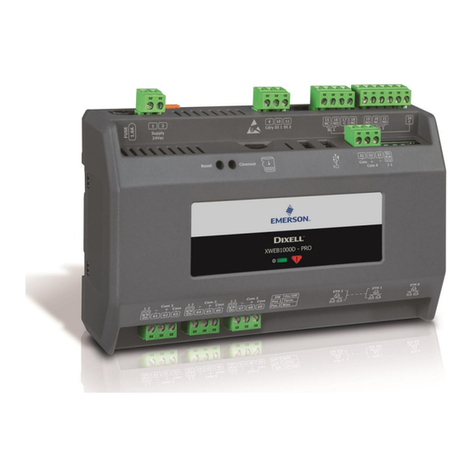
Emerson
Emerson DIXELL XWEB1000D PRO Installing and operating instructions
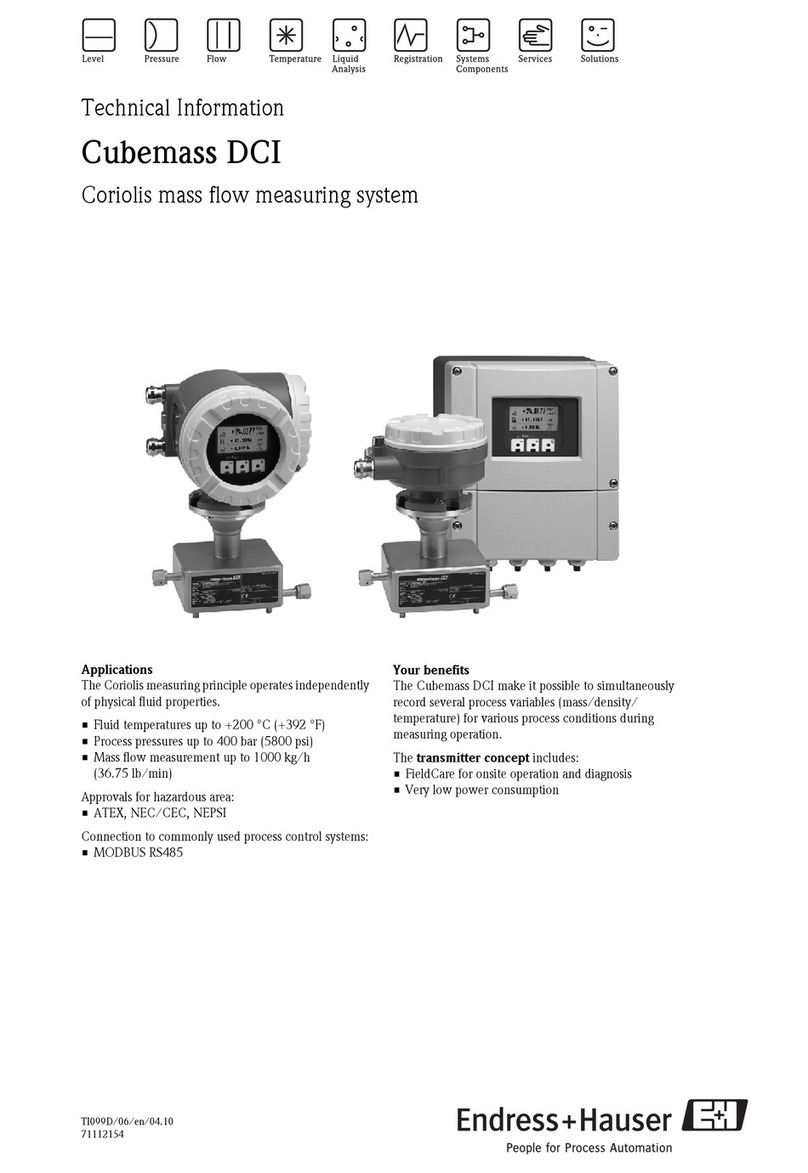
Endress+Hauser
Endress+Hauser Cubemass DCI technical information
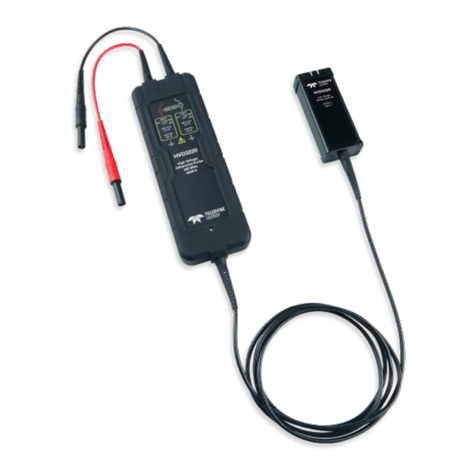
Teledyne Lecroy
Teledyne Lecroy HVD3000 Series Operator's manual
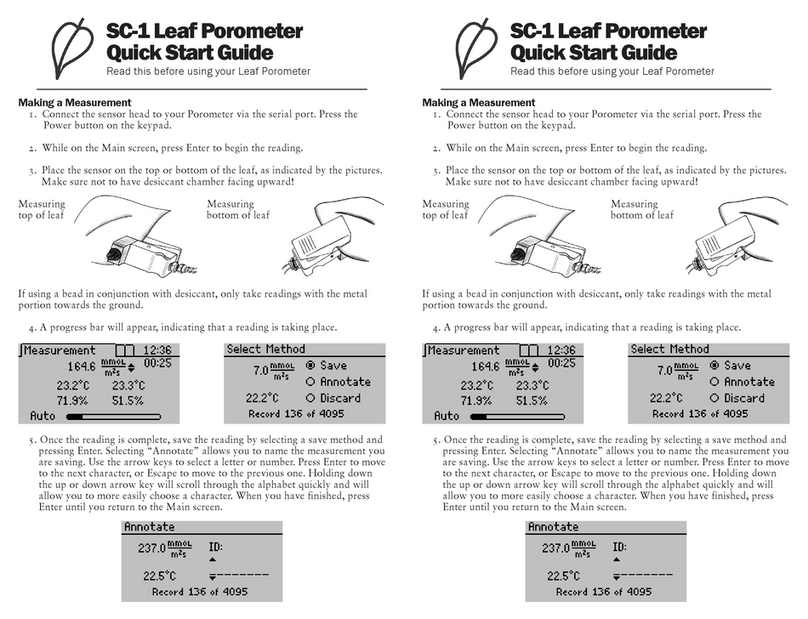
Decagon Devices
Decagon Devices SC-1 quick start guide

General
General CT6235B user manual
